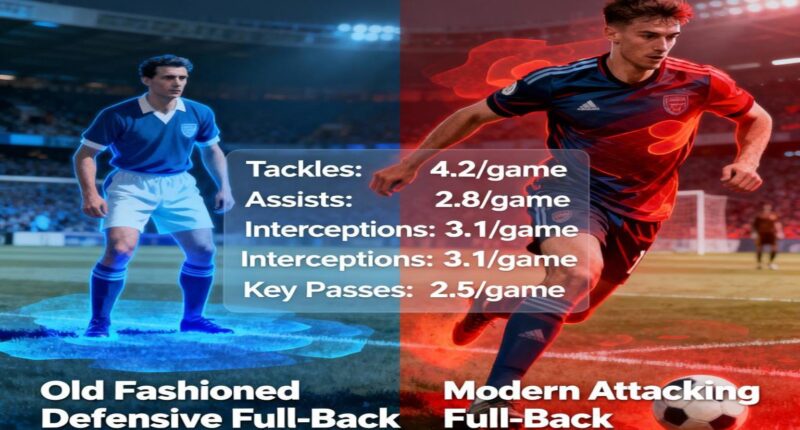Introduction: From Defensive Flankers to Tactical Kings
Traditionally, the full-back was football’s unsung specialist. Sitting wide in a back four, the primary task of these players was to thwart opposition wingers and provide occasional overlapping support for attacks. However, the advent of smarter data collection and tactical analytics in football has radically redefined what teams—and coaches—expect from full-backs.
Today’s best full-backs are as likely to be found creating goals as preventing them, orchestrating play from deep and wide positions, and racking up impressive statistics in assists, chances created, and even goals. But how did this radical shift occur?
The Traditional Full-Back: Roots in Defense
Early Defensive Foundations
For much of football history, the full-back’s game was defense-first. Players like Gary Neville and Ashley Cole epitomized this era: disciplined, positionally sound, and fiercely focused on stopping opposition threats down the flanks. Data analysis from early Premier League seasons supports this, with the majority of full-back touches and actions concentrated in their own half, rarely influencing play beyond the halfway line.
The Tactical Status Quo
Statistically, full-backs were among the least glamorous roles, with defensive metrics such as tackles, interceptions, and clearances predominating in evaluations. Their offensive input was, for decades, mostly measured by crosses—typically high balls swung into the box, and seldom factored significantly into overall attacking output.
Analytics and Tactical Innovation: The Catalyst for Change
Emergence of New Metrics
The rise of sophisticated data tools in football—tracking everything from heat maps to xG (expected goals) and involvement in open-play sequences—illuminated the potential impact of full-backs on all phases of play. Coaches began focusing not just on “where” a player ran, but “what” happened when they got there.
-
In the 2012-13 Premier League season, only 22.7% of full-back touches occurred in the attacking third; by 2021-22, this figure soared to 26.8%.
-
Full-backs’ contributions to chance creation moved from 15.9% to 20.4% in the same window, capturing their growing importance in team build-up and attack.
Changing Tactics: Inversions and Overlaps
The shifting data landscape coincided with tactical revolutions, particularly the rise of inverted and hybrid roles. Managers like Pep Guardiola and Jurgen Klopp unlocked the creative potential of full-backs by:
-
Encouraging playmaking from deep, centralizing full-backs’ positions and tasking them with dictating build-up play.
-
Emphasizing overlaps and underlaps to create numerical superiority in wide and half-space zones.
-
Incorporating data-driven models that tracked successful passes, progressive runs, and touches inside the final third.
This hybridization blurred the lines—full-backs became either supplemental midfielders (inverting inside to build play centrally) or secondary wingers (pushing high and wide).
Full-Back as Primary Playmaker: The Data Revolution
The Liverpool Model: Width, Output, and Data-Backed Dominance
The clearest modern example is Liverpool. Trent Alexander-Arnold and Andy Robertson personify the data-driven playmaker full-back:
-
Alexander-Arnold alone created 83 chances in one season, topping not just defenders, but most midfielders and forwards.
-
Liverpool full-backs contributed over 35% of the club’s total chances, leading the Premier League and directly shaping results.
-
Full-backs took 94.1% of corners, providing set-piece delivery and tactical variety.
Data revealed their centrality: each was involved in more than 60% of Liverpool’s open-play sequences, acting as persistent conduits between defense and attack.
Manchester City: Inversion, Control, and the “Midfield” Full-Back
Manchester City’s approach featured full-backs as deep-lying facilitators:
-
City’s full-backs contributed to 64.1% of the team’s open-play sequences but just 12% of direct chance creation, reflecting a focus on build-up and positional control.
-
Players like João Cancelo epitomized the pseudo-midfielder full-back, with data confirming high central involvement in playmaking, ball progression, and pressing.
Chelsea and Goal Threat
At Chelsea, full-backs not only created chances but also contributed directly to goals:
-
In a single campaign, Chelsea full-backs collectively scored 12 goals from 8.3 xG, highlighting the new expectation for full-backs to be direct goal threats.
Data-Driven Role Diversity: Styles Across the Elite
Tactical Flexibility
Today’s best teams deploy full-backs to fit distinct tactical identities, as dictated by their data profiles:
-
Some sides (Liverpool, Bayern Munich) favor attacking, creative full-backs, maximizing width and offensive input.
-
Others (Manchester City, Arsenal) prefer inverted, possession-heavy role players who build centrally and supplement midfield structure.
-
Even teams less reliant on expansive play (Crystal Palace) show varied data—creating only 11.9% of total team chances via full-backs.
Data-Identified Full-Back “Types”
-
Traditional overlapping: Constant up-and-down runners, high crossing frequency—e.g., Alphonso Davies, Andrew Robertson.
-
Inverted midfielders: Narrow, possession-centric, centrally positioned—e.g., João Cancelo, Oleksandr Zinchenko.
-
Hybrid “upgrades”: Center-back profiles operating in full-back slots, maximizing defensive solidity alongside playmaking—e.g., João Cancelo, Joško Gvardiol.
The Numbers Behind the Shift
Offensive Contribution
-
Aggregate increases in touches, passes, and xA (expected assists) for top full-backs over the last decade underline their new creative mandate.
-
More recently, players like Alexander-Arnold and Achraf Hakimi are ranked among football’s top playmakers by primary creative metrics, not just among defenders but across all positions.
Defensive Responsibility
-
While the attacking role has grown, top clubs use data to strike balance: “wide warriors” are still tracked by tackle percentage, pressure rate, and defensive third actions.
-
Some full-backs remain highly defensive by data (e.g., Fraser Aird and Chrisnovic N’Sa in the CPL), showing the diversity driven by team needs and league context.
Impact on Training, Scouting, and Player Development
Data-Driven Talent Identification
Modern scouting leverages detailed statistics—tackles won per 90, progressive passes, creative actions—to profile and recruit full-backs that suit tactical frameworks. The expectation is no longer that full-backs will merely defend; clubs want multi-dimensional contributors whose data matches organizational DNA.
Coaching Innovation
With analytics, training drills specifically target playmaking under pressure, pressing from the front, attacking movement into the half-spaces, and set-piece delivery. Video analysis and statistical dashboards further reinforce feedback loops and continuous development.
The Future: Where the Data Points
Ever-Growing Influence
With full-backs now responsible for over 20% of team chance creation (up from less than 16% a decade ago) and highly involved in tactical pressing and transitional play, it’s clear that data has forever changed the position.
Towards Total Football
The full-back may soon become the paradigm of the “universal footballer”—a player who must excel in multiple phases, with the data profile of a midfielder, winger, and defender rolled into one.
Conclusion
The journey of the full-back from defensive anchor to playmaking engine showcases how deeply data analytics shape elite football. Tactical innovation, combined with relentless data collection and analysis, has produced multi-skilled, high-impact players defining the rhythms and outcomes of modern games. For coaches, analysts, and aspiring talents, the modern full-back is the sport’s most exciting experiment—and testament—to the power of data-driven evolution









